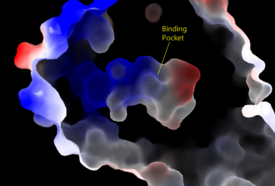Sandbox Reserved 1789
From Proteopedia
This page, as it appeared on June 14, 2016, was featured in this article in the journal Biochemistry and Molecular Biology Education.
SHOC2-PP1C-MRAS
Introduction(SMP) is a ternary holophosphotase complex formed by the individual proteins: SHOC2, PP1C, and MRAS. The SMP complex is involved in signaling the initiation of MAPK pathways, which is responsible for cellular growth and development, cell proliferation, and apoptosis [1]. Formation of this complex begins with an extracellular signal binding to a membrane embedded receptor tyrosine kinase receptor(RTK) [1]. This causes membrane-bound MRAS to exchange GDP for GTP. Initiating the SMP complex formation at the plasma membrane consists of the SHOC2 and PP1C binding first. When the MRAS exchanges GDP to GTP, it then assembles with the combined SHOC2 and PP1C. Based on MRAS targeting, PP1C catalyzes the dephosphorylation of the N-terminal phosphoserine (NTpS) on the RAF complex leading to the amplification of MAPK signaling [1]. In a normal cell, this would regulate cell proliferation but dysfunction in the ternary complex has shown signs to lead to tumor formation due to unregulated cell growth [1]. Overall StructureSHOC2is a scaffold protein composed of 20 leucine-rich repeat (LRR) domains that form a solenoid structure [1]. The leucine rich region forms a concave hydrophobic core which is necessary for binding with PP1C and MRAS. SHOC2 is the crucial mediator for SHOC2-PP1C-MRAS complex formation [1]. The leucine rich domain is very important in creating selectivity for the PP1C protein, as that protein is used for so many other complex pathways [1]. The LRR domains are stabilized by an N-terminal flanking 𝝰-helix and a C-terminal helix-turn-helix [2]. Alongside the conserved leucine residues in the LRR domain, there is a group of conserved asparagine residues that creates a stabilizing “asparagine ladder” that is necessary for the LRR fold, giving the SHOC2 its concave structure [2]. SHOC2 is also capable of causing various forms of Rasopathies. A common one is caused by a mutation known as p.S2G [3]. This mutation causes the formation of an additional 14-carbon saturated fatty acid chain on the N-terminal glycine of SHOC2 [3]. This causes SHOC2 to become attached to the cell membrane, resulting in a prolonged dephosphorylation of RAF by PP1C [3]. With this abnormality, there is overexpression of the MAPK pathway and increased cell proliferation genes [3] PP1C
MRAS
Key Ligand Interactions Figure 3: Electrostatic illustration of the amphipathic binding pocket of the LPA1 receptor. This binding pocket was revealed by cutting away the exterior or the protein. This binding pocket, located in the interior of the protein, has both polar and nonpolar regions. The blue and red coloration highlight the positively and negatively charged regions, respectively, and the white color shows the nonpolar region of the binding pocket. SHOC2 and PP1C
SHOC2 and MRAS
PP1C and MRAS
Signaling Pathway
Disease RelevanceCancerRASopathiesFuture Studies3D structures of lysophosphatidic acid receptor4z34, 4z35, 4z36 - hLPA1 + antagonist - human References
Proteopedia ResourcesCategory:Lysophosphatidic acid binding Category:Lysophosphatidic acid Butler University Proteopedia Pages See also: | ||||||||||||
Student Contributors
Madeline Gilbert Inaya Patel Rushda Hussein


